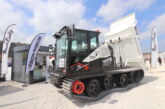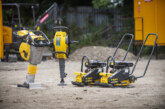
By the time you read this the date for the government’s call for evidence on non-road mobile machinery (NRMM) and its decarbonisation options will have passed – it was the 26th of March for the record. Hopefully, the industry will have heeded Lord Bamford’s words when he said that the “call for evidence is a crucial milestone that should be taken very seriously by everyone who is affected, from trade associations to owners and users of non-road mobile machinery.”
“It is vital everyone affected engages in this process to help determine which technologies are appropriate to achieve a net zero future. In JCB’s case, we will highlighting the important role that hydrogen will play alongside electric technology for smaller products.”
No doubt there will now be a period of intense scrutiny, reflection and debate by the relevant departments – Department for Energy Security and Net Zero, Department for Transport and last, but by no means least, the Department for Environment, Food & Rural Affairs.
What will they be looking for? Well, answers to the below:
- how NRMM is used across different sectors of the economy.
- what efficiency measures, process changes, and fuel switching technologies might be required to decarbonise NRMM.
- what issues may affect the development and deployment.
- whether existing policies are sufficient to decarbonise NRMM in line with net zero; and
- whether the policy principles of the Industrial Decarbonisation Strategy should also apply in relation to determining whether there is a case for further government intervention to support NRMM decarbonisation.
Let’s not underestimate the challenge ahead of them. To understand why then simply take a look at the accompanying feasibility study by consultancy ERM, issued at the same time as the call for evidence. At 195 pages it is a weighty tome and covers just about every angle you can think of.
For instance, the study concludes that ‘data scarcity makes decision making challenging for NRMM market actors and policymakers. With limited data on the UK NRMM fleet and typical duty cycles, it is difficult to create sector- wide decarbonisation strategies and justify investment in abatement options, particularly efficiency improvements.’
It goes on to say that ‘the suitability of technologies depends on a wide range of parameters that are very specific to the site and machinery, including tasks performed, utilisation levels and the size, duration, and location of the site. Care should be taken therefore when drawing conclusions about the future of industrial NRMM.’
In light of that, one must hope that, in responding to the call for evidence, OEMs and the like provide meaningful data and tangible evidence that can help this government (more likely the next) to define the way ahead and determine the extent of its intervention to support NRMM decarbonisation. And let’s face it, a strategy is needed if the industry is to reduce its current emissions output, currently estimated to be 11.4 million tonnes of CO2 equivalent (MtCO2e) per year. That is equivalent to 2.7% of all the UK’s greenhouse gas emissions.
Happy reading,
The CPN team








